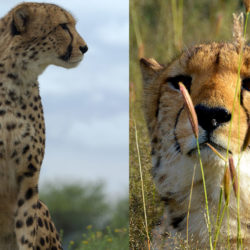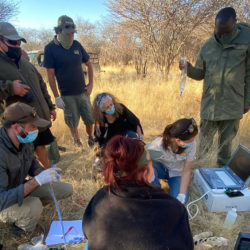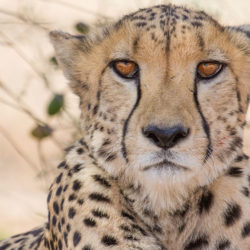Update on Resident Cheetah Solo
-

- by Lora Allen April 25, 2018

n the 26th March, our longest standing resident, Solo, had surgery to remove her eye. For the weeks prior to the surgery Solo had developed a small ulcer on her right eye, the source we are still unsure of. We began treatment to help the ulcer heal immediately with regular eye drops and medication, unfortunately our efforts to help the eye heal were unsuccessful and it spread across her eye eventually starting to cause her pain and discomfort. After long discussions regarding our next move, we made the decision to remove her eye completely to avoid any more complications. This decision was not made lightly as she is 18 years old, so this was a risky surgery for her, but we had no other options.
The whole procedure went incredibly smoothly, Solo was given a good manicure and truly pampered whilst the keepers had the opportunity to groom her! Her eye was removed and sent off for testing to determine the cause of the ulcer in case it was infectious as it spread quickly and did not respond to veterinary treatment. She was returned to her enclosure in the afternoon and monitored closely until she was comfortable and awake.

Since the surgery, Solo has recovered well and quickly! The eye socket has been closed and is healing well already starting to regrow fur back, she’s now nicknamed pirate cat by her keepers! She’s eating well and is getting used to her new life with more restricted vision. Her keepers have given her a strict routine in her enclosure to ensure she can get around well with minimal stress. For example, her water bowl and food bowl are always in the same place. Her shelter has fresh straw that she can smell and stays in the same place too, so she can orientate easily.
She is already back to her feisty self, telling the young boys off through the fence! We are closely monitoring her behaviour daily to ensure she continues to have a stress-free retirement. The cheetah department have set up a programme involving our interns and a data collection technique named “ethogram” to monitor her. An ethogram is a way of cataloguing behaviours and activity levels whilst observing animals. It is a chart that can be broken down into minute by minute behaviours or as much as hourly behaviours. This gives the keepers a really good idea of how she is managing and what she gets up to during the day.
Camera traps have also been set up in her enclosure to make sure she is managing to find her water and shelter when it rains. All is going well, and she is very much enjoying the extra attention from everyone! A lot of the interns studying her behaviour have noted she will come and sit along the fence line with them when they are monitoring her.
Related Reading
-
April 5, 2022
Eulogies for Ron and Khayjay -
November 5, 2021
Field Scans and Clinic Exams with SoundVet -
October 18, 2021
Eulogy for Resident Cheetah B2




